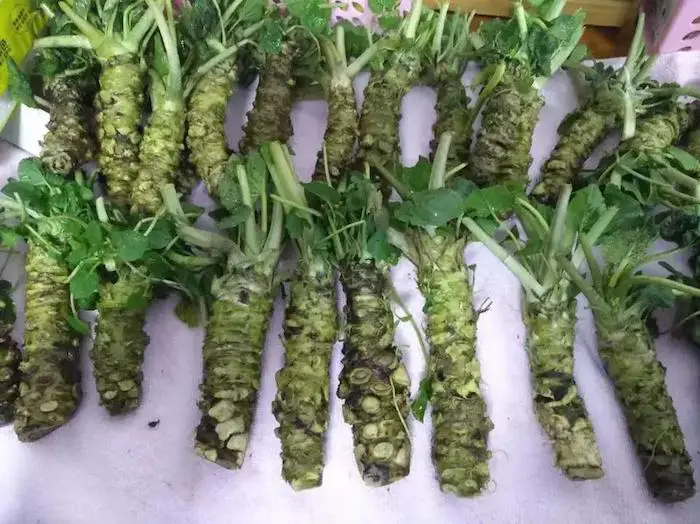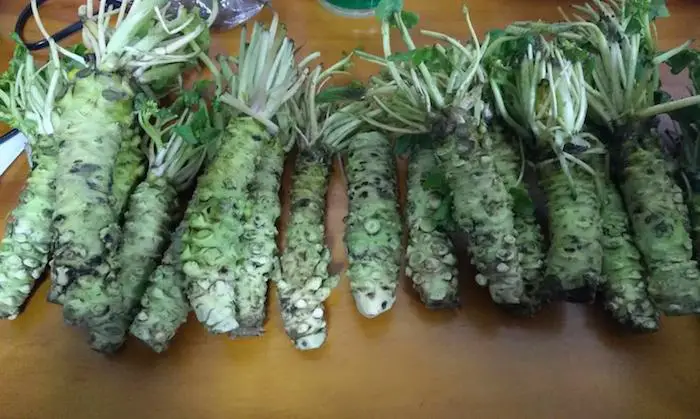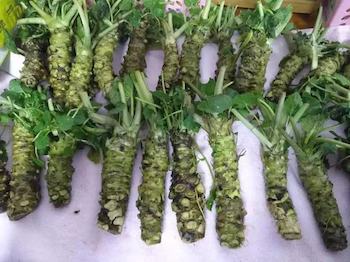We are reader supported. When you purchase through links on our site, we may earn an affiliate commission. Also, as an Amazon affiliate, we earn from qualifying purchases.

If you are a sushi fan, you have probably noticed that green paste your chef serves on your plate with sushi every time. Love it or hate it, but you can’t escape this popular Japanese condiment and just a little is enough to give you a spicy kick that overpowering the taste of sushi.
My friend once asked me ‘How much does a wasabi root weigh?’ I looked up for an answer and found that raw wasabi root (sliced) can weigh about or 4.59 ounce per US cup or 137.37 gram per metric cup. The rhizomes you can see at online stores weigh nearly 2 ounces or 60 grams in weight.
The weight does not affect the taste of wasabi, and once the plant is mature, the taste remains the same throughout. Further research revealed that it contains 109.01 calories per 100 grams. Read on to find out interesting facts about this wonder root and what makes it is so expensive.
Contents
Wasabi Is Actually Not A Root?
While many people believe that wasabi paste comes from the root of the wasabi plant, the spicy green mass that is grated is actually the lower part of the stem, not precisely the root. As real wasabi like this is expensive and hard to grow, many restaurants use horseradish and other substitutes dyed green to look similar.
As per historical evidence, the Japanese have been adding wasabi to enhance dishes for over a thousand years. It is believed to have medicinal properties that lie in the stem, not the root. Besides preventing foodborne illnesses caused due to eating raw fish and seafood, it also adds a spicy kick to the dishes.
Although many people prefer to call Japanese horseradish, it is a herbaceous plant (Brassicaceae) which belongs to the cabbage family. If you visit a wasabi field, it looks nothing like what you see in the market. All you can see are fresh green leaves. However, calling it Japanese cabbage doesn’t sound as good, don’t you think!
What Does Real Wasabi Look And Taste Like
Known as Wasabia japonica (scientific name), this perennial plant comprises of a thickened stem (rhizome), root, petioles, and green leaves. All the parts are harvested and valued for use. However, the stems or rhizomes serve as the storage area for the plant’s nutrients, and this is where the flavors tend to be most concentrated.

Contrary to what people usually think, the real wasabi is a rhizome that looks like a mass of roots, similar to turmeric or ginger. When the rhizome is grated to make a paste, it gives you a pungent condiment to be used with sushi and other Japanese foods
What you get is a super-spicy flavor that goes up to the nasal passage and stays there for some time, resulting in a runny nose in some cases. Real wasabi has a complicated vegetable flavor like artichoke hearts or asparagus and includes some floral components with a dash of sweetness.
A study conducted in New Zealand in 2003 explains that wasabi has high levels of isothiocyanates, a volatile compound that adds a unique flavor and aroma that ranges from a punch-in-the-nose-heat to feeling green and then fatty.
Why Is Wasabi So Expensive?
Wasabi is often known as the ‘Goldilocks’ of the plant world as it requires specific conditions and takes more than a year to grow. The plant can be adversely affected by too much or too little sunlight so that it can be cultivated only in particular areas.
Furthermore, the plants require a lot of water that is between 55 and 65 degrees Fahrenheit. As a result, wasabi farmers usually grow them in the mountainous regions in Japan where the plants get enough water and temperature is constantly maintained.
If the proper requirements for farming are not fulfilled or anything goes wrong, the entire crop is lost for the season because it takes too long to grow again. Difficulty in growing results in less number of real wasabi on the market for sale. Thus, the price is high (up to $160 per pound) due to limited supply and great demand.
What Is Fake Wasabi?
Due to its high price, most of the restaurants outside Japan serve fake wasabi made of horseradish dyed green using food colors. Although it has a similar hot kick to it, horseradish misses the sweetness and health benefits of real wasabi.
Some restaurants may make wasabi paste using wasabi powder, mustard, and other flavorings, so chances are you have probably not tasted real wasabi before. Next time when you visit a sushi bar, ask the chef what they use to make wasabi paste. If they use real wasabi, you should relish the taste.
The wasabi you get in the supermarket is also made of other substitute ingredients used to imitate the real stuff. If you want to taste real wasabi paste, check out the specialty shops but expect to pay high.
Interesting Facts About Wasabi
In Japan, wasabi is not just eaten with sushi or sashimi. The Japanese believe that the rhizome can reduce the risk of food poisoning; hence they use it in a variety of dishes such as soba noodles, steak, oysters, and other seafood.
Wasabi is grown in mountainous terrains in the river valleys, away from direct sunlight. The roots reach the underground water, and the plants grow only 1300 – 2500 meters above sea level. The plants don’t thrive in temperatures below 8°C or more than 20°C.
This is not a plant that you can grow in your back yard as it requires a lot of determination to cultivate it for commercial purpose. However, if you manage to go through the stressful cultivating period successfully, you will be rewarded as wasabi roots cost $100-$160 per pound.
If you buy a real wasabi root, be careful when using it. If you leave grated wasabi uncovered, it will lose its authentic flavor in 15 minutes. As wasabi is expensive, make sure you eat it within 15 minutes to avoid wasting it.
Contrary to the short life span of grated wasabi, the real wasabi rhizome can retain the flavor for months if stored correctly. While you should grate only as much paste as needed, the stem can last for several months when stored under proper conditions.
The wasabi stems are not the only edible and useful parts of wasabi. In Japan, people also eat the leaves. They can be eaten raw or pickled to make a dish called wasabi zuke. They may also be included in recipes to give it a distinct flavor or add a little kick.
How To Make A fresh Paste Out Of Real Wasabi
Let’s assume that you are lucky enough to get your hands on a real wasabi rhizome (mostly known as wasabi roots). You need to prepare a fresh paste to enjoy it with sushi and other delicacies. For more detailed explanation, read this article.
Steps to follow:
• Rinse the wasabi root to remove any dirt and dust.
• Trim the tip of the root at one end.
• Take a sharp knife and remove the tough outer layer (make sure you don’t expose more than needed)
• Next, you will need a grater like this to make a fine paste. I recommend using this traditional Japanese grater made of shark skin.

• Rub the exposed part against the grater to get a pile of a fine paste. Use the area that you have peeled.
• Consume this fresh paste in the next 15 minutes before it loses the optimal flavor.
Pro tip: If for any reason, you don’t eat wasabi paste within 15 minutes of the grating, it will lose the flavor and become simply hot. The subtle flavor can be revived by mixing 1-2 pinches of granulated sugar (superfine) vigorously per teaspoon of paste. This will help in restoring the flavor/ complexity temporarily.
Related Questions
How long can wasabi last?
If the wasabi root is fresh, it can last for up to a month in your refrigerator if stored properly. Make sure you wrap the wasabi is a moist paper towel or damp cloth (not wet) after use and keep the paper moist. Change the paper towel every day and make sure it never dries out.
If you notice the root turning brown, trim that side and discard. This will not hurt the entire root but ensure that it lasts for longer.
How long does it take for a wasabi plant to mature?
Typically, the plants can require three years to reach full maturity. When the right conditions are provided, the plant results in a robust top and root growth. It can reach an approximate knee height of 2 feet with a similar overall width.
Where does real wasabi grow?
The plant grows in the northern region of Japan, and parts of Taiwan, China, and New Zealand. In North America, several methods are used to cultivate wasabi in the rain forests of Oregon Coast and the Blue Ridge Mountains in Tenessee and North Carolina. They provide the perfect conditions for wasabi to grow.
Why is real wasabi so rare to find?
Due to hard growing conditions and longer maturity periods, it is impossible for farmers to fulfill the demand for wasabi. As a result, restaurants outside Japan mostly use a common substitute made of horseradish, starch, mustard, and green color. Spinach powder may also be used to add green color.
How long can the wasabi rhizome grow?
The stems, which are used for making wasabi paste can grow to a maximum length of 12 to 18 inches and have a diameter of up to 40 mm (1.5 inches). The growth terminates in heart-shaped leaves that can be as large as a plate under optimum conditions.


Comments
Pingback: How to Make Real Wasabi at Home? - Easy Homemade Sushi
Pingback: Do You Put Wasabi On Sushi? - Easy Homemade Sushi